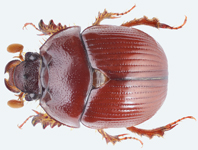Abstract
The millipede genus Striaria Bollman, 1888 heretofore had been thought to be confined to the Appalachian region of eastern North America, is replaced in western North America by species of the genus Amplaria Chamberlin, 1941. Collections from northern Idaho show that this is not the case, and that at least four species of Striaria occur in the west. These species are described herein as Striaria aculeata n. sp., S. bombillus n. sp., S. vagabundus n. sp. and S. orator n. sp.
References
Bollman, C.H. (1888) Notes upon a collection of Myriapoda from East Tennessee, with a description of a new genus and six new species. Annals of the New York Academy of Science, 4, 106–112.
https://doi.org/10.1111/j.1749-6632.1889.tb57035.x
Bollman, C.H. (1893) The Myriapoda of the United States. United States National Museum Bulletin, 43, 1−210.
Causey, N.B. (1952) Four chordeumoid millipedes from the United States. Proceedings of the Biological Society of Washington, 65, 111−118.
Causey, N.B. (1958) New records and descriptions of a new genus and a new species of millipeds of the family Striariidae (Chordeumida). Proceedings of the Biological Society of Washington, 71, 179−184.
Causey, N.B. (1960) Speostriaria, new genus (Diplopoda: Chordeumida: Chordeumidea: Striariidae). Proceedings of the Biological Society of Washington, 73, 25−28.
Chamberlin, R.V. (1910) Diplopoda from the western states. Annals of the Entomological Society of America, 3, 233−262, pls. XXX−XLIII.
https://doi.org/10.1093/aesa/3.4.233
Chamberlin, R.V. (1941) New western millipeds. Bulletin of the University of Utah, Biological Series 6, 31(2), 3−23.
Chamberlin, R.V. (1947) Seven new American millipeds. Proceedings of the Biological Society of Washington, 60, 9−16.
Cook, O.F. (1899) The diplopod family Striariidae. Proceedings of the United States National Museum, 21, 667−676, pls. LIII + LIV.
https://doi.org/10.5479/si.00963801.21-1169.667
Hoffman, R.L. (1950) Records and descriptions of diplopods from the southern Appalachians. Journal of the Elisha Mitchell Scientific Society, 68, 11−33, pls. 1−8.
Hoffman, R.L. (1999) Checklist of the millipedes of North and Middle America. Virginia Museum of Natural History Special Publication, 8, 1−584.
Loomis, H.F. (1936) New millipedes of the American family Striariidae. Journal of the Washington Academy of Sciences, 26, 404−409.
Shear, W.A. (2020) The millipede family Striariidae Bollman, 1893: I. Introduction to the family, synonymy of Vaferaria Causey with Amplaria Chamberlin, the new subfamily Trisariinae, the new genus Trisaria, and three new species (Diplopoda, Chordeumatida, Striarioidea). Zootaxa, 4758 (2), 278−295.
https://doi.org/10.11646/zootaxa.4758.2.4
Shear, W.A. (2021) The millipede family Striariidae Bollman, 1893: II. New records and species of the genus Amplaria Chamberlin, 1941 (Diplopoda, Chordeumatida, Striarioidea). Zootaxa. 4908 (2), 205–224.
https://doi.org/10.11646/zootaxa.4908.2.3
Shear, W.A., Krejca, J.K. (2007) Revalidation of the millipede genus Amplaria Chamberlin 1941 (Diplopoda, Chordeumatida, Striariidae) and description of two new species from caves in Sequoia and Kings Canyon National Parks, California. Zootaxa, 1532 (1), 23−39.
https://doi.org/10.11646/zootaxa.1532.1.2
Shear, W.A., Nosler, P. & Marek, P.E. (2017) The identity of Amplaria nazinta (Chamberlin, 1910): a century-old millipede mystery resolved (Diplopoda, Chordeumatida, Striariidae). Zootaxa, 4311 (2), 233−240.
https://doi.org/10.11646/zootaxa.4311.2.4


